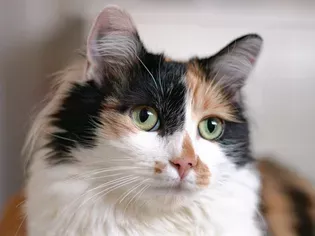Are Calico Cats Always Female?
Updated on 04/26/24

Are Calico Cats Always Female? Unraveling the Enigma of Nature's Patchwork Beauties
In the vibrant tapestry of the feline world, calico cats stand out as captivating enigmas, their coats swirling with a harmonious symphony of black, orange, and white. These mesmerizing felines have long captivated our hearts and curiosity, leading to the enduring question: Are calico cats always female? Embarking on a captivating journey into the realm of genetics, we unravel the truth behind this feline mystery.
Unveiling the Genetic Secrets: A Tale of X-Chromosomes
The key to understanding the gender bias in calico cats lies within the intricacies of their genetic makeup. Unlike humans, who possess two X-chromosomes in females and one X and one Y-chromosome in males, cats have a different chromosomal arrangement. Female cats inherit two X-chromosomes, while male cats inherit one X and one Y-chromosome.
The X-chromosome harbors the genes responsible for coat color, and it is this genetic inheritance that shapes the unique calico pattern. Orange and black fur coats are determined by two distinct genes located on the X-chromosome. In order for a cat to express both colors, it must inherit two copies of these genes—one from each X-chromosome.
The Probability Conundrum: Unraveling the Female Dominance
This genetic requirement immediately poses a challenge to male cats. Since they inherit only one X-chromosome, they can only carry either the orange or the black gene, making it impossible for them to express both colors simultaneously. Consequently, male calico cats are extremely rare, accounting for less than 1% of the calico population.
Exceptional Exceptions: The Rarity of Male Calico Cats
While male calico cats are a rarity, they do exist, albeit in very limited numbers. This phenomenon occurs when a male cat inherits an additional X-chromosome, resulting in an XXY chromosome configuration. Known as Klinefelter syndrome, this genetic variation allows the cat to express both orange and black fur, creating the distinctive calico pattern.
Historical Anecdotes and Scientific Evidence
The scarcity of male calico cats has been documented throughout history. In his book "The Variation of Animals and Plants under Domestication," Charles Darwin noted the extreme rarity of male calico cats, suggesting that they occurred only "once in several thousand births." Modern scientific studies have corroborated Darwin's observations, with researchers confirming that male calico cats comprise a tiny fraction of the calico population.
Calico Cats in Culture and Folklore
The unique appearance and rarity of calico cats have woven them into the fabric of human culture and folklore. In Japanese culture, calico cats are known as "mi-ke" or "san-ke," and are often associated with good luck and prosperity. In North America, calico cats are sometimes referred to as "money cats" due to their perceived ability to attract wealth.
Examples Illustrating the Gender Disparity
To further illustrate the extreme rarity of male calico cats, consider the following examples:
* In a study conducted by the University of California, Davis, researchers analyzed over 3,000 calico cats and found only one male calico.
* The Guinness World Records recognizes "Touché" as the oldest living male calico cat, who passed away in 2020 at the age of 26.
* In 2019, a male calico cat named "Bruce" became an internet sensation after his owner shared photos of his striking orange, black, and white coat.
Conclusion: Resolving the Enigma
Based on the overwhelming genetic evidence, we can conclusively state that calico cats are almost always female. The vast majority of calico cats inherit two X-chromosomes, enabling them to express both orange and black fur. Male calico cats, while exceptionally rare, can occur when a male cat inherits an additional X-chromosome, resulting in the XXY chromosome configuration. These extraordinary felines serve as a testament to the intricate workings of genetics and the captivating diversity of the natural world.
Explore More Pets

Cat Behavior Problems
How to Stop Aggression in Kittens

Long-Haired Cat Breeds
Siberian Cat: Breed Profile, Characteristics, & Care

Cat Behavior Problems
How to Stop Kittens From Scratching and Biting

Long-Haired Cat Breeds
Turkish Angora: Cat Breed Profile, Characteristics & Care

Basic Training
How to Socialize Your Kitten

Short-Haired Cat Breeds
Cute Pictures & Facts About Calico Cats & Kittens

Litter Box Training
Training Your Kitten to Use the Litter Box

Long-Haired Cat Breeds
10 Fun Facts About White Cats